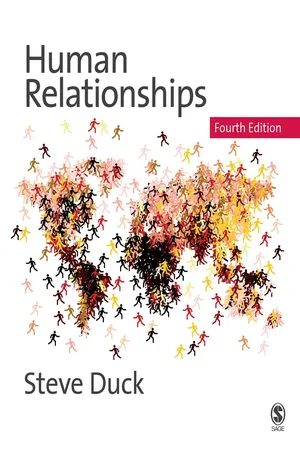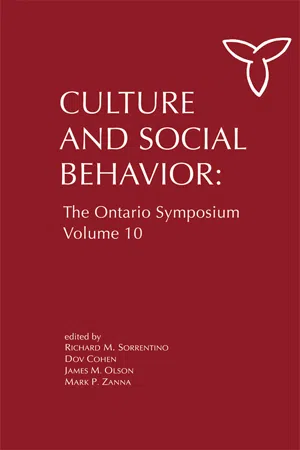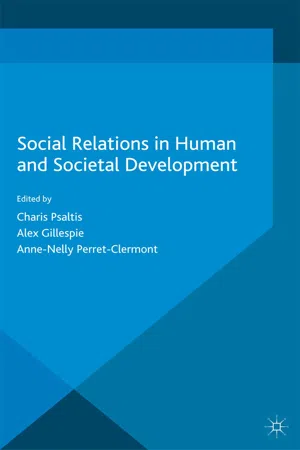Psychology
Cultural Differences in Relationships
Cultural differences in relationships refer to the varying norms, values, and communication styles that exist across different cultures and can impact how individuals form and maintain relationships. These differences can influence aspects such as gender roles, conflict resolution, and expressions of love and affection, and understanding them is crucial for promoting healthy and successful cross-cultural relationships.
Written by Perlego with AI-assistance
Related key terms
Related key terms
1 of 4
Related key terms
1 of 3
7 Key excerpts on "Cultural Differences in Relationships"
- Jane Jackson(Author)
- 2019(Publication Date)
- Routledge(Publisher)
intraracial relationships (interpersonal relationships between individuals from the same socially constructed racial group). Not all societies are receptive to intercultural relationships, especially when they are of an intimate or romantic nature. Negative reactions can certainly hamper or even prohibit intercultural unions. In addition to individual characteristics and skills, societal norms and attitudes can play a significant role in determining whether intercultural connections flourish or falter.Crossing boundaries in intercultural relationships
Intercultural relationships can take many forms and cross one or more socially and historically constructed boundary (e.g., class, race, language, religion). People may develop affiliations with individuals from different ethnic, linguistic, national, racial, and religious backgrounds or form bonds with those who differ in terms of such dimensions as age, ability (e.g., linguistic, physical, mental), gender, social class, and sexual orientation. The following section briefly describes various types of intercultural relationships and provides examples of each.Interracial relationships
As noted in previous chapters, ‘race’ is a culturally and historically transmitted concept. Orbe and Harris (2015: 9) define it as ‘a largely social- yet powerful- construction of human difference that has been used to classify human beings into separate value-based categories’. As Goodman et al. (2012: 251) observe, ‘[a]mong humans there are no races except the human race’. Notions of race form the basis of racism and many interculturalists reject the use of the term. Nonetheless, perceptions and attitudes toward ‘race’ can still impact intercultural communication, and the formation of interracial relationships remains a sensitive issue in many parts of the world (Goodman et al- eBook - ePub
Foundations for Couples' Therapy
Research for the Real World
- Jennifer Fitzgerald, Jennifer Fitzgerald(Authors)
- 2017(Publication Date)
- Routledge(Publisher)
Intercultural couple relationships have historically been unusual and formed against the wishes of the partners’ families and societies. In some places, these relationships were even against the law. However, in recent years the world’s population has become increasingly mobile and connected, and attitudes are changing. Rapid increases in intercultural marriage rates have been reported around the world. However, there is evidence that intercultural couples still face greater difficulties than intra-cultural couples. Intercultural couples are at higher risk of divorce than intra-cultural couples, and this risk increases with the extent of difference between the partners’ cultures (Kalmijn, de Graaf, & Janssen, 2005). Therefore, it is essential for couple therapists to acquire knowledge and skills to assist this growing population.Cultural Differences in Couple Relationships
The dimensions of individualism and collectivism provide a simple framework via which cultural differences in couple relationships can be understood. In individualistic cultures, people are perceived as separate beings whose behaviour is primarily determined by internal attributes (Markus & Kitayama, 1991). Young people are expected to develop independence and discover and express their unique abilities, ideas, feelings and preferences. People are defined by their individual characteristics, and validation of these forms the basis of self-esteem. In contrast, in collectivistic cultures, people are defined by their relationships with others (Markus & Kitayama, 1991). Behaviour is determined by perceptions of others’ thoughts, feelings and actions, and self-esteem is derived from fitting harmoniously into the group. Suppression of individuality for the sake of group harmony is regarded as a sign of maturity. International studies indicate that European countries and former European colonies tend to be high in individualism, while Asian, African and Latin-American countries tend to be high in collectivism (see e.g., Hofstede, Hofstede, & Minkov, 2010).These cultural differences in values give rise to different relationship standards. Romantic love is central to the Western conceptualization of a good couple relationship. Falling in love is considered the first step of a couple relationship and lack of love a reason for ending it. This is likely to be due to the value placed on self-determination and pursuit of individual fulfilment in individualistic cultures. Therefore, keeping romance alive in the relationship is considered an important task for partners and is a component of many Western couple therapies. - eBook - ePub
- Steve Duck(Author)
- 2007(Publication Date)
- SAGE Publications Ltd(Publisher)
This simple pairing of examples brings up the fact that the analysis of relationships is available at many different levels, from the microbiological analysis of chemical changes wrought by sexual desire or depression and individual endocrine performance effects on a pair’s marital interaction to the oppressive cultural machinery that has historically directed women to a place of relational inferiority, treating them as the property of fathers and husbands for centuries, for example. Yet even now we do not think it odd that parents have the sort of relational power that allows them to take their children to a vacation spot of the parents’ choosing without the children being consulted, that children may be denied their choice of playmates by disapproving parents, and that some marriage ceremonies still ask ‘Who giveth this woman to be married to this man?’ The media may debate the ‘rightness’ of same-sex marriages and we may feel horror when a paedophile is convicted at the same time as we share with our friends mildly amused joking references to Michael Jackson who was acquitted of such charges. So even if relationships are based on biology it is clear that immediate individual psychological and social communicative processes combine with distant societal and sociological forces to influence our ways of looking at them in a living society where people do not satisfy themselves merely by passing around self-rating questionnaires or the contents of their catheters but actually talk to one another in a social context.CONTEXTS FOR ANALYSING RELATIONSHIPS
The mystery that a book about human relationships must confront therefore is that there is simultaneously far too much to be said and far too little known about the nature of relationships, far too much that is commonsense and far too little that is understood about the reasons why relationship processes are either common or sense, and far too much that is personally important about the everyday practical consequences of understanding relationships for it to be left only to science, even if that could be restricted to one sort of science (from the physiological to the sociological).In brief, then, both of these above levels, the physical/physiological and the media frames in a culture, affect human relationships and the ways in which behaviour in them is created and then understood. Accordingly, we must not allow our first thoughts about human relationships to overlook either the biological or the many contexts that create and modify expression and interpretation of personal preferences. Even if desire has a physical basis, real life practical constraints limit our ability to act on our emotions and ‘Why can’t we do it in the road’ even with our spouse. Culture constrains expression of biologically-based desire. This book explores research on relationships with an emphatically contextual lens and teaches that even individual liking is not just individualistic and desire is only infrequently the simple origin of actual relational behaviour. Biology and culture, personal meaning systems created in early childhood, communication, ‘audiences’ for the performance of our relational behaviour, and nonverbal communication which goes beyond – and modifies the meaning of – the felt emotion and the spoken word modify relationships. Other contexts (the papers or TV, for instance) both facilitate and limit this apparently most private of areas – personal - Dominik Schoebi, Belinda Campos(Authors)
- 2019(Publication Date)
- Routledge(Publisher)
People in different cultures have different objectives and ideals in close relationships. Yet, relationship research has often failed to take this variation into account. In fact, much of the research on close relationships started from universalist assumptions based on individuation and separation as being universal trajectories across relationship contexts. In the present chapter, I demonstrated what it might mean for close relationship research if it did question universality. To this aim, I showed for a selection of relational processes that cultural variation not only exists, but that cultural variation—at least in a comparison of North American/Western European and East Asian contexts—is systematic und can be understood from the relative cultural foregrounding of an independent versus and interdependent mode of relating. How people establish secure attachment, how they form and structure romantic relationships, how they handle conflict, and, finally, which emotions play a central role in their close relationships all varies between cultures along the lines of independence and interdependence.To date, research on cultural differences in close relationships is relatively limited and receives only scant attention. For example, only two out of 37 chapters in the recent Oxford handbook of close relationships focused on the role of culture in close relationships (Simpson & Campbell, 2013). In fact, much of the relational research that is available focuses on convenience samples of friends or non-acquainted strangers. I believe that much can be gained by studying cultural variation in relational processes in close relationships, as these are the relationships in which cultural meanings are most commonly passed on, instantiated, and negotiated. In my view, studying cultural variation in relational processes would benefit relationship science as well as cultural psychology: It would not only lead to an appreciation of the many ways in which people form and manage close relationships across cultures, but research on the cultural underpinning of close relationships would also allow cultural psychologists to better understand the “making” of culture, e.g., by studying the microgenesis of how cultural differences emerge during actual interactions (rather than merely demonstrating that- eBook - ePub
- Miles Hewstone, Wolfgang Stroebe, Klaus Jonas, Miles Hewstone, Wolfgang Stroebe, Klaus Jonas(Authors)
- 2016(Publication Date)
- BPS Blackwell(Publisher)
Völkerpsychologie (normally translated as ‘folk psychology’), which included discussion of differing cultures around the world. More recently psychologists have discussed cultural differences in terms of variations in attitudes, values and beliefs. These variations can contribute to our understanding of the concept of culture if we take them into account. In the remainder of this chapter, we examine studies that are relevant to issues that have been discussed in preceding chapters, particularly in relation to social cognition, self-concept, personal relationships, group behaviour and intergroup relations. In each of these areas we will show how attention to cultural differences can enrich our understanding of social psychological processes.CULTURE AND CULTURAL DIFFERENCES
What is culture and why should we study it?
The opening chapter of this book discusses some of the best-known and frequently discussed social psychology experiments. Most of these experiments were conducted in the United States and some in the United Kingdom. What would happen if they were repeated somewhere else in the world? We can answer this question, because there have been attempts at cross-cultural replication of all these studies, some of them many times. Consider first an early study of group dynamics that was published by Schachter (1951). In this study, Schachter set up a series of student discussion groups. Unknown to most group members, each group contained an accomplice of the experimenter. The accomplice (the ‘deviate’) was instructed to take up a position opposed to the views of the majority and stick to his position. Schachter predicted that the deviate would over time receive less and less attention and be rejected by the group, which is just what he found among his US respondents.cross-cultural replication a test of whether the results of a study are the same if it is repeated as exactly as possible in another cultural context.A few years later, Schachter and seven colleagues (1954) reported on the results of a slightly different version of this study that was conducted in seven different European nations. In this case, groups of 11-year-old schoolboys were asked to decide which of several model aeroplanes to build. The results were complex and not at all as the experimenters had predicted. The groups in France did almost all reach agreement and did reject the deviate, as predicted. However, many of the groups in Belgium, West Germany (as it was then known) and the UK did not reach agreement at all, and ratings on a 7-point scale as to whether the deviate should leave the group varied greatly between nations, as shown in Figure 15.1 - eBook - ePub
Culture and Social Behavior
The Ontario Symposium, Volume 10
- Richard M. Sorrentino, Dov Cohen, James M. Olson, Mark P. Zanna(Authors)
- 2005(Publication Date)
- Psychology Press(Publisher)
Chapter 4Culture and Relationships: The Downside of Self-Contained Individualism
Kenneth L.Dion and Karen K.Dion, University of TorontoOur work has focused on cultural perspectives on heterosexual love, including issues pertaining to love and interdependence and love and views of self. When we first considered these issues in the 1980s (K.L.Dion & K.K.Dion, 1988), little research was being conducted on the cultural context of close relationships by social or crosscultural psychologists in Canada or the United States, who studied topics such as attraction, love, relationship development, or relationship maintenance. We contended, then as now, that social psychological phenomena such as love and intimate relationships can be more fully understood by considering the societal and cultural context, particularly family structure and societal norms pertaining to close relationships.The statement that “They met, fell wildly in love, married (or cohabited) and hoped to live happily ever after” exemplifies one (indeed, several) cultural scripts, rather than necessarily being a universal description of the nature and sequence of adult pair-bonding. Consider the following statement provided by a young woman describing the development of her relationship with her fiancé: “We never talked about the word love when we saw each other; therefore I trust him deeply and respect him very much.” The young woman was Chinese; the quote is from Hsu’s (1981) analysis of the different connotations of the word love in traditional Chinese society, as contrasted with what he characterized as the North American view of love. Hsu suggested that when thinking of romantic love: “An American asks, “How does my heart feel?” From the perspective of Chinese cultural traditions, an individual would ask: “What will other people say?” ”Many, if not all, cultures contain folk tales and stories of passionate love attachments. In some cases, however, these are cautionary tales, not tales of ideal relationships. We have argued in various papers and presentations over the past 15 years (K.K.Dion & K.L.Dion, 1991, 1993, 1996a, 1996b; K.L.Dion & K. K.Dion, 1993) that the sociocultural constructs of individualism and collectivism have relevance for understanding the psychology of love and different cultural scripts for romantic love. The aforementioned quote from Hsu, in fact, nicely captures how the meaning of a close personal relationship such as heterosexual marriage can be interpreted very differently depending on the relative emphasis on fulfilling personal desires and one’s obligations to others. - C. Psaltis, A. Gillespie, A. Perret-Clermont, C. Psaltis, A. Gillespie, A. Perret-Clermont, C. Psaltis, A. Gillespie, A. Perret-Clermont(Authors)
- 2015(Publication Date)
- Palgrave Macmillan(Publisher)
Part IIISocial Relations of the Economic Culture and Financial Crisis: Social, Cross-Cultural and Cultural Psychological PerspectivesPassage contains an image 9 The Role of Economic Culture in Social Relationships and Interdependence
Ayse K. UskulIntroductionCulture is a broad term with a plethora of meanings. Thus any discussion of how it shapes human psychology must lay the groundwork by defining the parameters of the analysis. In this chapter, I situate culture within economic environments, asking how certain socioecological features in a given economic community shape interactions to affect social psychological and cognitive outcomes. Instead of situating culture within individuals and considering how culture is perceived or construed by them, I focus on culture as it exists in objective circumstances that are observable to anyone (for a similar distinction, see Jahoda, 2011). This approach draws on Oishi’s discussion of socioecological psychology (Oishi, 2010, 2014; Oishi & Graham, 2010) and Medin’s references to a cultural ecosystem (e.g. Medin et al., 2013), both of which emphasize the systemic interactions between, or mutual constitution of, social/ecological environments and human mind/behaviour. It also bears a resemblance to cultural-ecological (e.g. Berry, 1979; Whiting & Edwards, 1988; Keller, 2011; Adams et al., 2012) and sociocultural (e.g. Plaut et al., 2002; Maynard & Greenfield, 2003; Adams, 2005) approaches to the study of the interplay between culture and psychology.Although I recognize the mutual constitution of social/ecological environments and human mind/behaviour, and I acknowledge the importance of studying how human psychology may shape economic systems, I limit the present discussion to research on the relationship between economic systems and a few select cognitive or social psychological outcome variables to highlight the role of the macroenvironment in human psychology. In particular, I focus on how the economic environment may shape social interdependence, thereby leading to certain ways of thinking and behaving.
Index pages curate the most relevant extracts from our library of academic textbooks. They’ve been created using an in-house natural language model (NLM), each adding context and meaning to key research topics.
Explore more topic indexes
Explore more topic indexes
1 of 6
Explore more topic indexes
1 of 4






